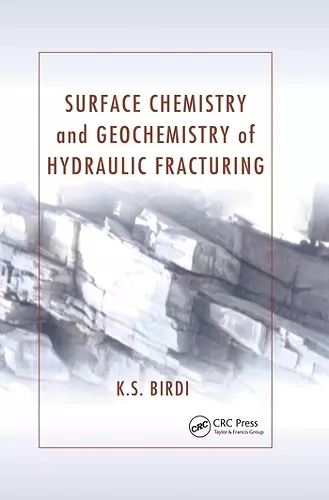Surface Chemistry and Geochemistry of Hydraulic Fracturing
Format:Paperback
Publisher:Taylor & Francis Ltd
Published:28th Apr '20
Currently unavailable, and unfortunately no date known when it will be back
This paperback is available in another edition too:
- Hardback£180.00(9781482257182)

Unique in focus, Surface Chemistry and Geochemistry of Hydraulic Fracturing examines the surface chemistry and phenomena in the hydrofracking process. Under great scrutiny as of late, the physico-chemical properties of hydrofracking are fully detailed and explained. Topics include the adsorption-desorption of gas on the shale reservoir surface and relevant waste-water treatment dependent on various surface chemistry principles.
The aim of this book is to help engineers and research scientists recognize the basic surface chemistry principles related to this subject.
Written by a long-time expert in the field, this book presents an unbiased account of the hard science and engineering involved in a resource that is gaining growing attention within the community.
‘This is a comprehensive, unbiased, and technical treatment of a very complex and controversial topic. The author is qualified to evaluate the subject, as he is a widely published expert who has been involved in this and other related areas of research for over 50 years. … Engineers and research scientists involved in the extraction of oil and gas and in waste water treatment will find this work the most helpful.
Summing Up: Recommended. Graduate students, faculty, and professionals.’
–M. E. McCallum, Colorado State University for Choice, May 2017, Vol. 54 No. 9.
'This book is an essential pedagogical reference of interfacial processes for the fracking technologist, written in an easy-to-absorb style. Fundamental knowledge of interfacial forces is presented within a thermodynamic context, relating interfacial forces to thermodynamic quantities as well as physical processes. A comprehensive chemical perspective is thereby provided of governing physical phenomena in fracking systems, including wetting, adsorption/desorption, coagulation, flocculation, coalescence, foaming, and fracture-induction. Several experimental analytical techniques are discussed, including calorimetry, gravimetric gas adsorption, and emulsion stability determination. In addition, several techniques are presented for specifically measuring interfacial tension values, including contact angle, pendant drop, and Wilhelmy plate. The classic colloidal stability theory DLVO is presented along with an analysis of electro-kinetic processes and viscous forces. All of the advanced scientific theories are presented and discussed using common colloquial language, facilitating rapid understanding and mastery of the topics.
The rigorous thermodynamic, scientific approach adopted in this book ensures direct application to the design and engineering of industrial fracking fluids, reservoirs, and processes, while simultaneously retaining universal applicability to diverse shale compositions. As such, this book provides an effective roadmap for exploiting interfacial phenomenon within the design of industrial fracking systems. A broader view of the fracking industry is adopted, incorporating ancillary topics such as fracking wastewater treatment, oil spills, adhesion, EOR, and detergency. The overall scientific approach in this book opens up substantial insight into the role of interfacial chemistry within the fracking industry. An important reference book for the fracking technology industry.'
– Kristofer Gunnar Paso, Norwegian University of Science and Technology.
ISBN: 9780367516000
Dimensions: unknown
Weight: 453g
223 pages